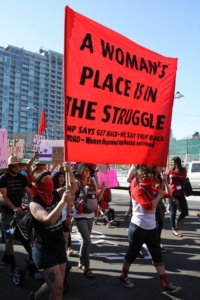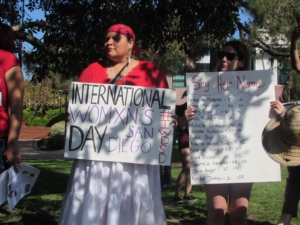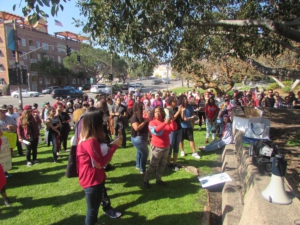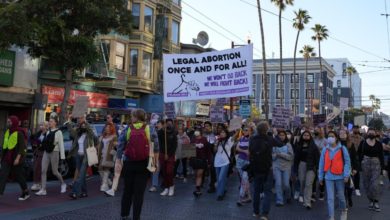 On March 11, men, women, and children came together in San Diego for International Women’s Day.
On March 11, men, women, and children came together in San Diego for International Women’s Day.
The march began at San Diego City College, with red shirts and bandanas covering the crowd. The people took the streets of downtown San Diego, headed to the San Diego police headquarters, and then finally to Horton Plaza park. Chants rang through the streets: “No justice, no peace! No racist police!” and, “When (Muslin lives/queer lives/migrant lives/people of color) are under attack, what do we do? Stand up, fight back!”
The overall feeling of the march was militant and strong. The powerful energy radiated through each and every person while marching solidly together. Women of San Diego’s PSL branch marched at the front of the crowd with their banner “A Woman’s Place is in the Struggle,” held high, while other comrades were interspersed throughout the rest of crowd. Onlookers honked and cheered in solidarity.
 The Brown Berets took the responsibility as the security force. They took posts at the front and end of the marching crowd, ensuring the safety of all from both counter-protesters and the police and managed to protect the crowd from a police car that got dangerously close to hitting members of the march while heading to Horton Plaza park.
The Brown Berets took the responsibility as the security force. They took posts at the front and end of the marching crowd, ensuring the safety of all from both counter-protesters and the police and managed to protect the crowd from a police car that got dangerously close to hitting members of the march while heading to Horton Plaza park.
 The focus on the march was on women of color, and the speakers spoke out strongly for themselves and their sisters in their fight for safety and equality. Powerful stories and voices of women of color filled the air. One Black woman spoke about law enforcement brutality experienced by oppressed communities in front of the police headquarters, while another woman spoke on sexual and domestic violence. In front of Horton Plaza, a Native woman spoke on homelessness and food insecurity faced by countless women. Finally, a union sister and Latina spoke on her current struggles within the UFCW and the sexual harassment forced upon her by union leader Mickey Kasparian. The crowd stood vigilant, listening intently to every speaker, vowing justice for all.
The focus on the march was on women of color, and the speakers spoke out strongly for themselves and their sisters in their fight for safety and equality. Powerful stories and voices of women of color filled the air. One Black woman spoke about law enforcement brutality experienced by oppressed communities in front of the police headquarters, while another woman spoke on sexual and domestic violence. In front of Horton Plaza, a Native woman spoke on homelessness and food insecurity faced by countless women. Finally, a union sister and Latina spoke on her current struggles within the UFCW and the sexual harassment forced upon her by union leader Mickey Kasparian. The crowd stood vigilant, listening intently to every speaker, vowing justice for all.
The event ended where it began, back at City College, during which musical performances took place, and solidarity grew between activists both longtime and new.




